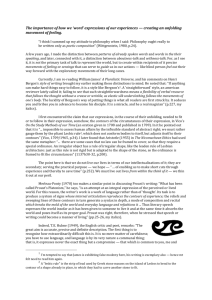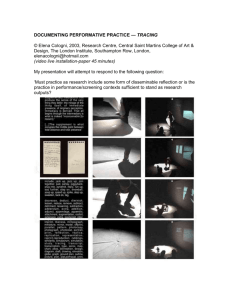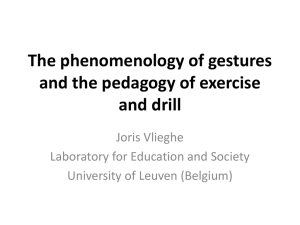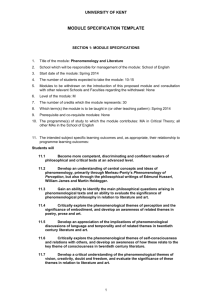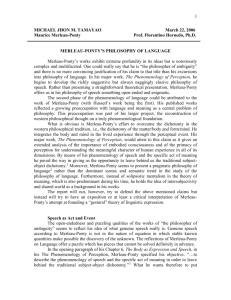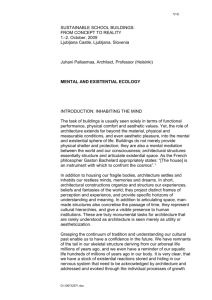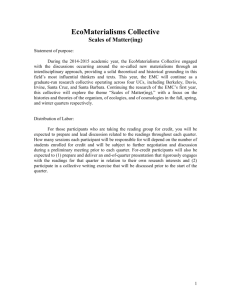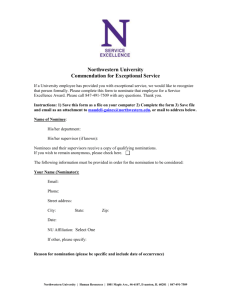Prof. Mauro Carbone - The Chinese University of Hong Kong
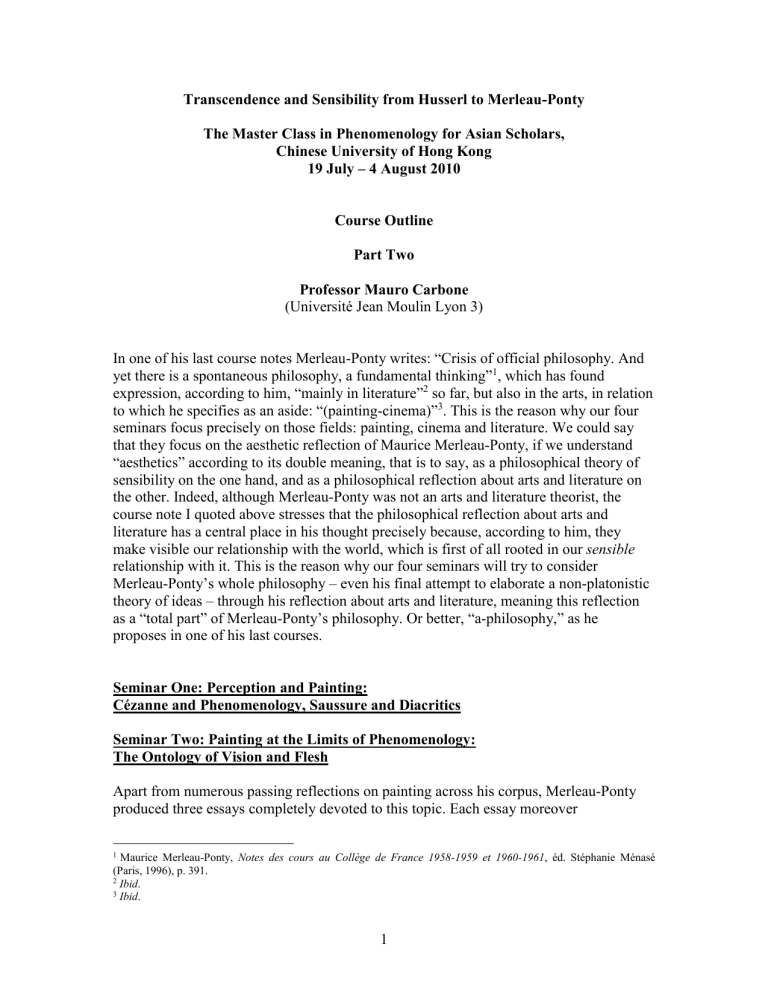
Transcendence and Sensibility from Husserl to Merleau-Ponty
The Master Class in Phenomenology for Asian Scholars,
Chinese University of Hong Kong
19 July – 4 August 2010
Course Outline
Part Two
Professor Mauro Carbone
(Université Jean Moulin Lyon 3)
In one of his last course notes Merleau-Ponty writes: “Crisis of official philosophy. And yet there is a spontaneous philosophy, a fundamental thinking” 1
, which has found expression, according to him, “mainly in literature”
2
so far, but also in the arts, in relation to which he specifies as an aside: “(painting-cinema)” 3
. This is the reason why our four seminars focus precisely on those fields: painting, cinema and literature. We could say that they focus on the aesthetic reflection of Maurice Merleau-Ponty, if we understand
“aesthetics” according to its double meaning, that is to say, as a philosophical theory of sensibility on the one hand, and as a philosophical reflection about arts and literature on the other. Indeed, although Merleau-Ponty was not an arts and literature theorist, the course note I quoted above stresses that the philosophical reflection about arts and literature has a central place in his thought precisely because, according to him, they make visible our relationship with the world, which is first of all rooted in our sensible relationship with it. This is the reason why our four seminars will try to consider
Merleau-Ponty’s whole philosophy – even his final attempt to elaborate a non-platonistic theory of ideas – through his reflection about arts and literature, meaning this reflection as a “total part” of Merleau-Ponty’s philosophy. Or better, “a-philosophy,” as he proposes in one of his last courses.
Seminar One: Perception and Painting:
Cézanne and Phenomenology, Saussure and Diacritics
Seminar Two: Painting at the Limits of Phenomenology:
The Ontology of Vision and Flesh
Apart from numerous passing reflections on painting across his corpus, Merleau-Ponty produced three essays completely devoted to this topic. Each essay moreover
1 Maurice Merleau-Ponty,
Notes des cours au Collège de France 1958-1959 et 1960-1961
, éd. Stéphanie Ménasé
(Paris, 1996), p. 391.
2 Ibid .
3 Ibid .
1
chronologically represents one of the three periods in which his thought can be subdivided. More importantly, each summarizes the essential characteristics of the period in which it appears. Listed chronologically, the essays are “Cézanne’s Doubt,” published in 1945, the same year of the Phenomenology of Perception, his most important complete work; “Indirect Language and the Voices of Silence,” published in 1952, where, typical of his early 50s work, he paid particular attention to language; and finally the last essay
Merleau-Ponty completed before his sudden death, Eye and Mind , written in 1960 but published in 1961. At the time of his death, he was engaged in an attempt to elaborate a
“new ontology” in the book entitled
The Visible and the Invisible , posthumously published in 1964. On this basis, in our first seminar we will focus our attention on
“Cézanne’s Doubt,” and then on “Indirect Language and the Voices of Silence,” whereas in the second seminar on “Eye and Mind,” always trying to locate each essay in the period of Merleau-Ponty’s thought within which they fall.
Seminar One - Readings:
Maurice Merleau-Ponty, “Le doute de Cézanne,” Fontaine , n. 47, 1945, pp. 80-100,
English translation: “Cézanne’s Doubt.” In G. Johnson (ed.), The Merleau-Ponty
Aesthetics Reader : Philosophy and Painting . Michael B. Smith translations editor.
Evanston: Northwestern University Press, 1993, pp. 59-75.
Maurice Merleau-Ponty,
Phénoménologie de la perception
(Paris: Gallimard, 1945).
English translation: Phenomenology of Perception , trans. Colin Smith (London:
Routledge & Kegan Paul, 1962; revised, 1981). In particular: “Preface”, pp. vii-xxi.
Maurice Merleau-Ponty, “Le langage indirect et les voix du silence,” Les Temps
Modernes , n. 80, 1952, pp. 2113-2144 and n. 81, 1952, pp. 70-94, English translation:
“Indirect Language and the Voices of Silence.”
The Merleau-Ponty Aesthetics Reader:
Philosophy and Painting , pp. 76-120.
Maurice Merleau-Ponty, La prose du monde.
Paris: Gallimard, 1969. English translation:
The Prose of the World
. Trans. John O’Neill. Evanston: Northwestern University Press,
1973. In particular “The Indirect Language,” pp. 47-113.
Maurice Merleau-Ponty, “Le monde sensible et le monde de l’expression.” In
Résumés de cours. Collège de France, 1952-1960
, Paris: Gallimard, 1968. English translation: “The
Sensible World and the World of Expression.” In In Praise of Philosophy and Other
Essays . Trans. John Wild and James Edie. Evanston: Northwestern University Press,
1988, pp. 71-79.
Seminar Two - Readings:
Maurice Merleau-Ponty, “L’oeil et l’esprit,” Art de France , n. 1, janvier 1961, pp. 187-
208. English translation: “Eye and Mind.” The Merleau-Ponty Aesthetics Reader:
Philosophy and Painting , pp. 121-149.
2
Maurice Merleau-Ponty, “Le philosophe et son ombre” [1959]. In Signes , Paris:
Gallimard, 1960. English translation: “ The Philosopher and His Shadow ,” in Signs , trans.
Richard McCleary, Evanston: Northwestern University Press, 1964, pp. 159-181.
Maurice Merleau-Ponty, “Philosophy and Non-Philosophy Since Hegel” [1961], trans.
Hugh J. Silverman, in Philosophy and Non-Philosophy Since Merleau-Ponty , edited by
Hugh J. Silverman, New York and London: Routledge, 1988, pp. 9-12.
Maurice Merleau-Ponty, Le visible et l’invisible , Paris: Gallimard, 1964. English translation: The Visible and the Invisible , trans. Alphonso Lingis, Evanston:
Northwestern University Press, 1968. In particular: “The Intertwining – The Chiasm,” pp.
130-149.
Mauro Carbone, The Thinking of the Sensible. Merleau-Ponty’s A-Philosophy , Evanston:
Northwestern University Press, 2004, pp. 14ff.
Mauro Carbone, An unprecedented Deformation. Marcel Proust and the sensible Ideas , trans. Niall Keane, Albany, NY: SUNY Press, 2010, chapter I.
Seminar Three, Part One: The Philosopher and the Moviemaker
Merleau-Ponty and Cinema between historical Convergence and ontological Novelty
As its subtitle underlines, the first part of the present seminar is devoted to the relations between Maurice Merleau-Ponty’s thought and cinema.
First of all, we focus on two topics, underlying the lecture on cinema given by Merleau-
Ponty in 1945. On the one hand, the reflection about the peculiarities of filmic expression and cinematic image; on the other, the convergence between the inspiration of cinema and that of philosophy, which Merleau-Ponty sees as a significant characteristic of his times: a convergence in which the nouvelle vague
’s cinema will recognise itself and which the French semiologist and historian of cinema Christian Metz will retrospectively confirm. Moreover, in developing both of these topics, we will trace the way to interpret
Merleau-Ponty’s lecture as an undeclared polemical response to Henri Bergson’s famous negative judgement about cinema.
Secondly, we put further references to cinema made by Merleau-Ponty, mainly in posthumous or unpublished writings, together with his later reflection about vision. This shows how the peculiar novelty of cinema is more and more understood by Merleau-
Ponty not only as historically convergent with a new way of conceiving philosophy, but as a symptom of the new ontology he was trying to formulate philosophically.
Seminar Three, Part One - Readings:
Maurice Merleau-Ponty, “Le cinéma et la nouvelle psychologie,” Les Temps Modernes ,
26, 1947, pp. 930-947. English translation: “The Film and New Psychology.” In Maurice
Merleau-Ponty, Sense and Non-Sense . Trans. Herbert L. Dreyfus and Patricia Allen
Dreyfus. Evanston: Northwestern University Press, 1964, pp. 48-59.
3
Maurice Merleau-Ponty,
Notes des cours au Collège de France 1958-1959 et 1960-1961
,
éd. Stéphanie Ménasé, Paris: Gallimard, 1996, pp. 390-392.
Maurice Merleau-Ponty et Jean-Luc Godard (propos recueillis par), “Le testament de
Balthazar,” Cahiers du cinéma
, 177, 1966, pp. 58-59.
Henri Bergson,
L’evolution créatrice, Paris: Alcan, 1907. English translation: Creative
Evolution , trans. Arthur Mitchell, London: Random House, 1954, chapter IV.
André Bazin, “The Ontology of the Photographic Image” [1945]. In
What Is Cinema?
,
Essays selected and translated by Hugh Gray, Berkeley: University of California Press,
1967, volume I, pp. 9ff.
Christian Metz,
“Le cinéma: langue ou langage?,”
Communications , Paris: Seuil, 4, 1964, pp. 52-90. English translation:
“The Cinema: Language or Language System?”. In
Film
Language. A Semiotics of the Cinema , trans. Michael Taylor, Oxford: Oxford University
Press, 1974, pp. 31ff.
Pierre Rodrigo, “Merleau-Ponty. Du cinema à la peinture: le ‘vouloir-dire’ et l’expression elementare” [2005]. In L’intentionnalité créatrice. Problèmes de phénoménologie et d’esthétique
, Paris: Vrin, 2009, pp. 235-255.
Stefan Kristensen, “Maurice Merleau-Ponty, une esthétique du mouvement,” Archives de
Philosophie , 69, 2006, pp. 123-146.
Seminar Three, Part Two: Remembering.
Merleau-Ponty between Husserl and Proust
While Proust’s
Recherche interests Merleau-Ponty throughout his career, the progressive development of this interest raises questions which lead him to deepen his own thought.
In the Phenomenology of Perception , first of all, this interest is concentrated on the
“body’s function in remembering.” In fact, Merleau-Ponty’s observations on this subject, like Proust’s, reveal a tendency to accentuate the corporeal tonality of temporal experience, particularly in relation to Husserl’s transcendental phenomenology. But at this stage of Merleau-Ponty’s meditation, the difference between his perspective and that of Husserl is not yet explicit. In the last phase of his thought, Merleau-Ponty’s perspective is thematized and developed on the basis of motifs of reflection provided once again by Proust’s
Recherche
, leading him to critique Husserl’s analysis of temporality as well as the ontology that subtends it.
Seminar Three, Part Two - Readings:
Maurice Merleau-Ponty,
Phénoménologie de la perception
(Paris: Gallimard, 1945).
English translation: Phenomenology of Perception , trans. Colin Smith (London:
Routledge & Kegan Paul, 1962; revised, 1981). In particular: “The Body as Expression, and Speech”, pp. 174-199, “Temporality”, pp. 410-433.
4
Maurice Merleau-Ponty,
Résumé de cours, Collège de France 1952-60
(Paris: Gallimard,
1968); “Themes from the Lecture Courses,” trans. John O’Neill, in
In Praise of
Philosophy and Other Essays , Evanston: Northwestern University Press, 1988. “The
Problem of Passivity: Sleep, the Unconscious, Memory” (orig. 1954-55), , pp. 114-120.
Maurice Merleau-Ponty, Le visible et l’invisible , Paris: Gallimard, 1964. English translation: The Visible and the Invisible , trans. Alphonso Lingis, Evanston:
Northwestern University Press, 1968. In particular: “Reflection and Interrogation,” pp. 3-
48; “Husserl Zeitbewuwusstsein—
,” pp. 190-191; “(Bergson) Transcendence –
Forgetting
– Time,”, pp. 193ff.; “‘Indestructible’ Past, and intentional analytic—and ontology,” pp.
243ff.; “Nature,” p. 267; “Time and Chiasm,” p. 267-268.
Mauro Carbone, The Thinking of the Sensible. Merleau-Ponty’s A-Philosophy , Evanston:
Northwestern University Press, 2004, “The Time of Half-Sleep: Merleau-Ponty between
Husserl and Proust,” pp. 1-13.
Seminar Four: Proust and the Sensible Ideas
As is well known, in the pages devoted to the Recherche that interrupt The Visible and the Invisible Merleau-Ponty attributes to Proust a characterization of the ideas that—like the one of love incarnated in the petite phrase of Vinteuil—appear to be inseparable from their sensible presentation, and therefore are impossible to isolate as positive entities that can be actively grasped. This is why Merleau-Ponty interprets this Proustian characterization in a substantially anti-Platonistic sense.
In the constant attention that Merleau-Ponty devotes to Proust, here is the principal motive that guides his reflection in the later phase of his work: with respect to an appropriate philosophical formulation of the mutated relationship with ourselves, with others, with things, with the world—ultimately a mutated relationship with Being—which Merleau-Ponty sees at work in our epoch, a different description of the relationship between the sensible and the intelligible becomes decisive, i.e., a new theory of Ideas. According to Merleau-Ponty, it was Proust, more than any other, who pushed in such a direction.
Seminar Four - Readings:
Marcel Proust,
Du côté de chez Swann
, in
À la Recherche du temps perdu , édition publiée sous la direction de J.-Y.
Tadié, “Bibliothèque de la Pléiade
”
, Paris: Gallimard, 1987, vol.
I. English translation:
Swann’s Way
, in Remembrance of Things Past , New York:
Vintage, 1981, vol. 1, trans. C. K. Scott-Moncrieff and Terence Kilmartin.
Maurice Merleau-Ponty, L'Institution dans l'histoire personnelle et publique, Le
Problème de la passivité, le sommeil, l'inconscient, la mémoire: notes de cours au
Collège de France, 1954–1955.
Paris: Belin, 2003, pp. 63ff. English translation:
Institution and Passivity: Course Notes for the Collège de France (1954–1955) . Trans.
Leonard Lawlor and Heath Massey. Evanston: Northwestern University Press, 2010
(forthcoming).
5
Maurice Merleau-Ponty, La Nature: Notes Cours du College de France , 1956–57, Paris:
Seuil,1995. English translation: Nature: Course Notes From the College de France, trans.
RobertVallier, Evanston: Northwestern University Press, 2003, pp. 173ff.
Maurice Merleau-Ponty, Le visible et l’invisible , Paris: Gallimard, 1964. English translation: The Visible and the Invisible , trans. Alphonso Lingis, Evanston:
Northwestern University Press, 1968, pp. 149-155.
Maurice Merleau-Ponty, Notes des cours au Collège de France 1958-1959 et 1960-1961 ,
éd. Stéphanie Ménasé, Paris: Gallimard, 1996, pp. 191-198 et pp. 390-392.
Mauro Carbone, An unprecedented Deformation. Marcel Proust and the sensible Ideas , trans. Niall Keane, Albany, NY: SUNY Press, 2010.
Recommended Further Reading
Mauro Carbone , “ Flesh: Towards the History of a Misunderstanding,” Chiasmi international , n. 4, 2002, pp. 49-64.
Mauro Carbone , “ Sensible Ideas between Life and Philosophy,” Graduate Faculty
Philosophy Journal , vol. 30, no.1, “Merleau-Ponty at 100”, 2009, pp. 125-135.
Mauro Carbone, “Merleau-Ponty at the Limits of Phenomenology,” In Alan D. Schrift,
The History of Continental Philosophy , volume 4, Phenomenology: Responses and
Developments , Edited by Leonard Lawlor, Durham: Acumen publishing, 2010
(forthcoming).
Martin Jay, Downcast Eyes. The Denigration of Vision in Twentieth Century French
Thought.
Berkeley-Los Angeles-London: University of California Press, 1994, Chapter eight: “The Camera as Memento Mori: Barthes, Metz, and the Cahiers of Cinema” .
Galen A. Johnson, (ed.), The Merleau-Ponty Aesthetics Reader : Philosophy and Painting .
Evanston: Northwestern University Press, 1993.
Galen A. Johnson, Thinking in Color: Merleau-Ponty and Paul Klee
, in V. M. Fóti
(edited by), Merleau-Ponty: Difference, Materiality, Painting , New Jersey: Humanities
Press, 1996, pp. 169-176.
Galen A. Johnson, The Retrieval of the Beautiful. Thinking Through Merleau-Ponty's
Aesthetics , Evanston: Northwestern University Press, 2010.
Andrea Pinotti, “The Touchable and the Untouchable: Merleau-Ponty and Bernard
Berenson,” in Ian Copoeru and Hans Rainer Sepp (eds),
Phenomenology 2005 ,
Bucharest: Zeta Books, 2007, pp. 479-498.
6
